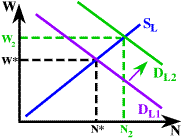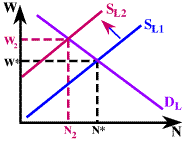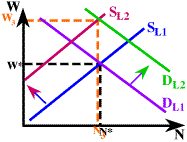

Copyright © 1995-2004 OnLineTexts.com, Inc. - All Rights Reserved
 6.
6.
This question requires you to consider two market changes, but it's easier if we look at them one at a time. The grape mold caused the price of wine to rise, since wine and beer are substitutes this leads to an increase or shift out in demand for beer. Since the demand for brewery workers is a derived demand, the demand for brewery workers shifts out to DL2 as well causing wages to rise to W2 and numbers hired to rise to N2 as shown to the right, but that's only part of the story.

At the same time, we find a shift in attitudes about working in breweries occurs making the job less deisrable. This means that fewer workers are willing to take jobs in breweries at every wage rate so the supply curve shifts back to SL2 as shown to the left. This would lead to an increase in wages to W2 and a reduction in numbers hired to N2. What happens when both changes occur at the same time?

When both changes occur at once wages must rise because both the increase in the demand for beer and the reduction in supply of workers pushes wages up. the two effect work together to increase wages to W3. However the increase in demand tended to increase hiring while the reduction in supply tended to decrease hiring. Since these two effects work in opposite directions we can't reliably predict whether numbers of brewery workers employed will rise or fall. As shown the numbers fall very slightly, but if demand shifted out a bit more and/or supply shifted back a bit less it could easily have gone the other way, so we must say the change is indeterminate.


Copyright © 1995-2004 OnLineTexts.com, Inc. - All Rights Reserved